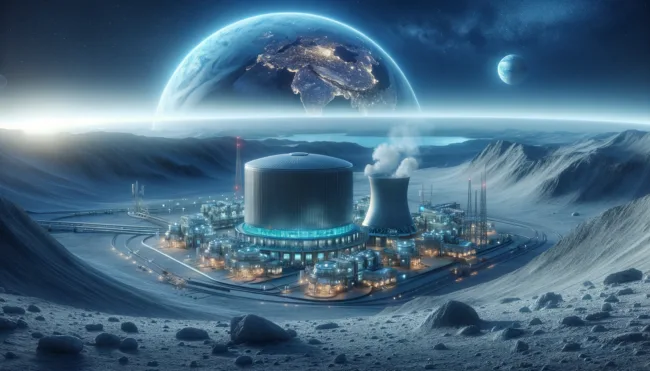Russia and China on secret plan to power the Moon: Nuclear fusion in space unveiled!
In an unprecedented move that marks a significant milestone in the modern lunar exploration race, Russia and China have set their sights on establishing a nuclear power plant on the moon’s surface, with plans for the project to be operational between 2033 and 2035. This ambitious initiative not only underscores the deepening strategic partnership between the two powerhouse nations in space exploration but also heralds a new era of technological advancement and cooperation beyond Earth’s bounds.
Yuri Borisov, the esteemed head of Russia’s space agency Roscosmos, took the lead in announcing this pioneering project. Borisov, with his rich background as a former deputy defence minister, emphasized Russia’s profound expertise in “nuclear space energy.” This expertise is poised to be a cornerstone of the collaborative lunar programme aimed at fostering sustainable lunar settlements, a testament to the visionary leadership steering this venture.
At the heart of this collaboration lies a compelling necessity to transcend the limitations posed by solar panels, which Borisov critiqued for their inability to meet the burgeoning electricity demands of future lunar habitats. The deployment of nuclear power emerges as a beacon of hope, promising to deliver a continuous and reliable energy supply to support these extraterrestrial communities.
Acknowledging the myriad complexities and challenges involved in situating a power unit on the lunar surface, Borisov highlighted the pivotal role of automation in mitigating risks, especially during the nascent stages of establishment, minimizing human involvement to ensure safety and efficiency.
Beyond the lunar power plant, Borisov shed light on Russia’s ambitious plans to develop a nuclear-powered cargo spaceship, whimsically dubbed a “space tugboat.” This advanced vessel, equipped with a nuclear reactor and high-power turbines, is designed to revolutionize the transportation of large cargoes between orbits, thereby enhancing the logistical capabilities of space missions.
However, the path to realizing these lofty ambitions is fraught with technical hurdles, such as the critical issue of cooling the nuclear reactor—a challenge that remains unresolved. Despite previous setbacks in lunar missions, Moscow’s unwavering commitment to lunar exploration shines through, buoyed by aspirations for joint missions with China and the ultimate goal of establishing a lunar base.
Parallel to Russia’s efforts, China’s ambitious space exploration endeavors, including its plan to send the first Chinese astronaut to the moon by 2030, illuminate the competitive yet collaborative spirit defining the contemporary lunar exploration race. Amidst international apprehensions regarding space militarization, Russian President Vladimir Putin’s dismissal of US warnings against the deployment of nuclear weapons in space underscores the intricate geopolitical dynamics at play in the quest to conquer and inhabit the lunar frontier.
This monumental collaboration between Russia and China not only paves the way for groundbreaking advancements in space exploration but also redefines the parameters of international cooperation in conquering the final frontier. As the world watches with bated breath, the realization of a nuclear-powered lunar base draws ever closer, promising to unlock new realms of possibility in human habitation beyond Earth.
The collaborative initiative between Russia and China to establish a nuclear power plant on the moon is not just a leap forward in lunar exploration; it represents a pivotal moment in human history. By overcoming the limitations of traditional power sources and harnessing nuclear energy for lunar habitation, this project sets the stage for sustainable human presence on the moon and potentially other celestial bodies. The complexities and challenges inherent in such a venture cannot be understated, but the strategic partnership and combined expertise of these two nations in space technology and nuclear energy herald a new era of space exploration. With each nation bringing its unique strengths to the table, the potential for success and the advancement of human knowledge and capabilities in space are immense.
Discover more from Business-News-Today.com
Subscribe to get the latest posts sent to your email.


